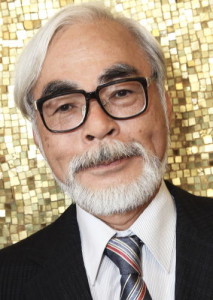
Considered to be the greatest living animation director, Hayao Miyazaki has made some of the best Japanese and animated films of all time. Films like My Neighbor Totoro, Princess Monoke, and Spirited Away can be found among many critics and audiences favorite films. Six films created by his studio can be found on IMDB’s Top 250 films list, with Spirited Away (2002) being the highest rated animated film on the list. Last week saw Miyazaki’s latest and last film reach the States, The Wind Rises. Shortly after its release in Japan, Miyazaki held a conference announcing his retirement from creating and directing feature-length films.
Back in September, at the age of 73, Miyazaki made his case for retiring. Claiming to be unable to work 12-14 hour work shifts, the job of animating, directing, and writing his own films was too strenuous and stressful.
“I know I’ve said I would retire many times in the past. Many of you must think, `Once again.’ But this time I am quite serious,” he said.
Miyazaki plans to continue overlooking the studio but is officially done with making feature films. Instead, he is now free to explore other things like becoming more involved with the Ghibli Museum revolves around his work and contributions.
Miyazaki, at a very young age carried an interest in animation. Fresh out of college in 1963, Miyazaki joined Toei Animation.Going through the ranks in the studio and switching workplaces throughout the years, Miyazaki got the opportunity to direct his first full length film in 1979. Based on the popular Lupin III series, The Castle of Cagliostro was an instant success. His next film Nausicaä of the Valley of the Wind (1984) based on his own manga series, led to his work as a director and animator becoming renowned for his effort and greatness.
In June 1985, Miyazaki and partners formed the animation company, Studio Ghibli. After the releases of Kiki’s Delivery Service (1989) and Porco Rosso (1992), Ghibli released Princess Monoke (1997). Becoming the bestselling movie at the time within Japan, it went on to win the Japan Academy Prize for Best Picture. Ghibli reached even higher heights with the release of Spirited Away (2002), breaking the records of their previous film, it became their bestselling movie. Critically acclaimed and considered one of the best films of the 2000s, it won Best Animated Feature at the Academy Awards. Their next two films, Howl’s Moving Castle (2004) and Ponyo (2008) carried the same amount of success and acclaim.
Many similar themes and tropes can be found amongst Miyazaki’s films that help represent his innovation and difference in the industry. More surprisingly, one common thing found amongst his films is the fact that they don’t carry true villains. The menacing characters that are featured have redeeming qualities and are often found on the heroes’ side by the end of the film. Miyazaki prefers to show a positive aspect of the worlds he creates by having good and evil coexist without being clearly differentiated.
Seeing the present as a complex time, he goes beyond many of the stereotypes found in children’s films to explore other themes that are also uncommon in this medium. Often emphasizing environmentalism throughout his films, as an attempt to “improve the vision of the world for children.” Supporting the environment and world peace, these movies feature anti-war themes, as Miyazaki shows the brutality and suffering caused by war with detail.
Most prominently found within all of his films are strong female protagonists who go against the gender roles that are found in animation and fiction.
Many of Miyazaki’s works deal with children. Showing the imaginative and explorative side of children, Miyazaki aims to give them an understanding of the world, in an era where the current generation has a lack of contact with nature.
Preserving his legacy, the Ghibli Museum, built in 2001, carries and showcases his Studio’s work dedicated to the art and technique of animation. Upon announcing the lifetime achievement award for Miyazaki in 2005, as director of the Venice Film Festival, Marco Mueller spoke of Miyazaki’s innovation.
“Miyazaki’s extraordinary vision unites romanticism and humanism. The sense of wonder that his films transmit reawakens the sleeping beauty in all of us,” Mueller said.
Miyazaki’s career as we know it has come to an end but his studio and legacy will continue to inspire children and adults, alike.